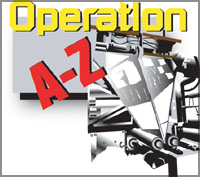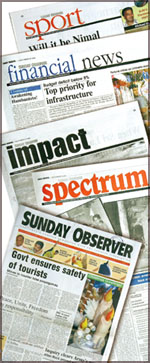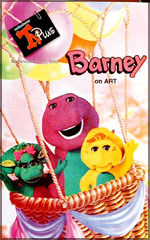|
Newspapers...
Formats, jargon and staff
 Newspapers... They are everywhere, in
many languages and many sizes too. If you are reading this article right
now, in your favourite children's newspaper, the Junior Observer, that
means you too, like millions of other people, invariably reach out for a
newspaper to know the hot news about what's happening around you, and Newspapers... They are everywhere, in
many languages and many sizes too. If you are reading this article right
now, in your favourite children's newspaper, the Junior Observer, that
means you too, like millions of other people, invariably reach out for a
newspaper to know the hot news about what's happening around you, and also to improve your knowledge on various topics as well as the
language.
also to improve your knowledge on various topics as well as the
language.
So, as newspapers are an integral (essential) part of your day-to-day
lives today, we thought of giving you a brief description of what
newspapers are, and the process of printing through our series
'Operation A-Z'.
As the newspaper industry (or the print media) is a very complex area
we will try to enlighten you about at least the basics. Hope you enjoy
reading about news papers and knowing how your favourite newspaper is
published, to reach your hands every Sunday...
Before we look into the process of printing, let's look at some
newspaper jargon, material used, the people involved and the different
types of newspapers that are printed today.
Of course, all of you must be aware by now as to what a newspaper is;
it is a publication which contains both local and foreign news, articles
giving information on various topics, cartoons, crosswords, editorials,
photographs and of course the advertisements which bring in the revenue
for the continuity of the newspaper.
Now, we'll look into the different types of newspapers that are being
printed today. You must be aware that some newspapers are rather small
in size compared to others, and also that some newspapers are available
on a weekly basis while others are there daily.
Well, the small papers are called tabloids, the larger ones are known
as broadsheets and others are called Berlines or Midi. The broadsheets
are considered the standard size newspapers.
Broadsheets are approximately 13-14 inches across and 21-22 or 23
inches high, while tabloids are 10-11 inches across and 14-18 inches
high.
 The
newspapers that are published Monday through Saturday are called the
'dailies' and those that are published only once a week, most often on
Sundays are weeklies. The Sunday Observer is a broadsheet, weekly
newspaper. The
newspapers that are published Monday through Saturday are called the
'dailies' and those that are published only once a week, most often on
Sundays are weeklies. The Sunday Observer is a broadsheet, weekly
newspaper.
Most broadsheet newspapers especially the weeklies, have various
tabloids issued free with them, like the Junior Observer. However, your
favourite children's paper is not just another children's tabloid that
comes with the main paper like most other such tabloids. It is
registered as a children's English newspaper in the country, like the
popular Sinhala newspaper Mihira,which is also published by Lake House.
We do not need to go into detail about the various tabloids and
broadsheets available in the market, but, one thing you must be aware of
is that most countries have at least one newspaper that circulates
throughout the entire country, which is known as the national newspaper.
 Newspaper
establishments are either state owned (completely under government
control) semi-government or privately owned. The owner of the newspaper
is known as the publisher and printer. The person in charge of the
newspaper is called the Editor or Editor-in-chief. Newspaper
establishments are either state owned (completely under government
control) semi-government or privately owned. The owner of the newspaper
is known as the publisher and printer. The person in charge of the
newspaper is called the Editor or Editor-in-chief.
There are various departments involved in the running and printing of
a newspaper, such as the Management, Editorial, Advertising, Production,
the Press, Circulation and Dispatch, to name the main components. Then,
there are sections such as the Graphics, Photo department, Data
operations and various others that come into play, to print and deliver
the newspapers to you.
The Editorial is headed by the Editor-in-chief or Editor. Associate
editors, various desk heads, reporters, sub-editors, cartoonists,
artists, photographers, graphic designers and operators, are others to
name a few.
As you know, a newspaper contains not only just news articles, but
various other feature articles pertaining to politics, science, business
and finance, entertainment, fashion, women, children, foreign news and
so on.
There are different journalists who write or specialise on these
various subjects and different desks too to handle these sections. They
are the news desk, features desk, business desk and sports desk.
Journalists who are responsible for bringing in the news are
'reporters' and most of them have their own special areas of reporting
which is known as a 'beat'. Some write only news articles, while others
specialise in writing feature articles or special columns, sometimes under their own names or
pen names.
feature articles or special columns, sometimes under their own names or
pen names.
This name, when published is called a byline in newspaper jargon
(language) and a special story that no other news media has published is
called a 'scoop' or 'exclusive' story.
Apart from news reporters and feature writers, there are people like
you who regularly send in various articles for publication, and they are
called contributors. Those who write in regularly without working at the
office are correspondents.
Then, there are journalists who write to one particular paper or to
many on a freelance basis who are called freelancers.
Well, now you roughly know who is responsible for the writing part.
Now let's check out the rest; those who correct the grammar and improve
the articles giving them headlines etc. sent by outsiders or written by
the staff are called sub-editors. They, along with graphic artists
design the page layouts. (We will highlight more about the pre-press and
printing process in our next issue of 'Operation A-Z').
Let's also check out how each section of the paper and an article are
classified; you may have seen how articles are displayed in the pages of
a newspaper in different sections.
The title of the newspaper which is always carried on the first page
right at the top usually is called the masthead (also called the
nameplate or flag) while the small advertisements (if any) on either
side are known as ear space. Each story that appears, be it a news
article or a feature article must have a heading which is called a
headline.
The main story is the lead article, which normally appears with a
large, boldface headline which is sometimes referred to as the banner
headline.
There could also be brief descriptions of the articles which are
referred to as 'blurbs' and straplines that add or explain what a
headline states.
The different styles used for lettering are called fonts which can be
used in bold or lightprint. Most articles are illustrated with
photographs or sketches. There are special photographers attached to
various papers and sections too.
Some photographers specialise in sports pictures while the others are
talented in capturing beautiful nature scenes or captivating human
interest pictures.
The main photograph is sometimes known as the 'bull picture' and the
details given under the picture are called a caption.
Apart from news reports and feature articles, there are cartoons,
most of which are political and are carried in the centre pages of the
first section known as the Editorial and Op-Ed pages, comic strips, mind
games and crosswords, photo features (which are mostly photographs with
a brief caption) astrology and various other columns and even
advertorials.
Now, don't get mixed up with editorials and advertorials. Editorials
usually are written by the Editor of a newspaper and reflects his/her
opinion and stand on various matters which could be either political or
general. Advertorials are articles or photo-features promoting certain
products or services.
There is so much more to write about this subject, but as space is
limited, what is already written should suffice to give you a general
idea about the various sections, and people involved in a newspaper.
However, before we close chapter on this article, we must enlighten
you on the material used to print the newspaper. We all know its paper,
but did you know that it is called newsprint and comes in different
thicknesses and quality?
The paper which is sometimes imported is brought to the 'press' as
gigantic reels and then cut to the required sizes at the press, during
the printing process.
Look out for details of the printing process in the next Operation
A-Z article.
***
Fact file...
* Broadsheet papers are generally traditional and formal; the
emphasis is on current affairs and feature stories. Tabloids tend to be
highly graphical, taking a more sensational approach in their news and
presentation.
* Advertising department provides a guide - what is known as a dummy
to the editorial, indicating the pages and sizes of advertisements in
the newspaper. The space left over after the ads have been placed on
each page is called the news hole. The space is measured by the
column inch. A broadsheet is divided into either 10 or 8 columns
while tabloids may be divided into 5 columns.
* A column inch is one column wide and one inch high. The lines
separating the columns or stories are called column rules and the
white space in between columns is called gutter space.
* The white space around the story is called 'air space'.
* The standard title for a newspaper journalist is reporter. A person
who is new to the field is known as a cub reporter or a
rookie. If the reporter covers news in an area away from the central
news office, he or she is known as a correspondent.
* A source is a person who provides a reporter information related to
a story. When a news 'provider' does not want to be identified, he/she
is referred to as a 'source' - official or unofficial.
* An expose is a story, often written in the format of a
feature that reveals (exposes) hidden corruption or a scandal.
* Hard news is a short story that gives a factual account of a
current issue.
* A banner is a large, front page headline that extends the
width of the page.
*A subhead is what appears in between the text and is usually
larger than the font size of the 'body copy'. It is in bold
type.
* Have you seen instructions given below an article directing the
reader to look for the rest of the article in another section of the
paper? Well, that is called a 'jump line', in newspaper jargon.
* The text that appears under a photo explaining it is not only
called a caption but also a cutline by some. The small
headline above the caption is called a catchline, and above the
photo is called an overline.
* Creditline is the text that identifies the photographer or
the source from where the material used (text or pix) was provided. |
